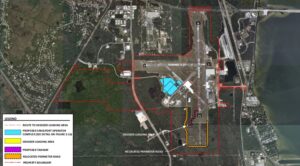Florida airport seeks spaceport license

SANTA FE, N.M. — A Florida airport is making progress on a long-running effort to obtain a commercial spaceport license despite a lack of customers for the facility.
In a Federal Register notice published Dec. 19, the Federal Aviation Administration announced the release a draft environmental assessment for the Space Coast Regional Airport in Brevard County, Florida, prepared as part of the airport’s application for a launch site operator’s license from the FAA’s Office of Commercial Space Transportation.
The report describes a proposal by the airport’s operator, the Titusville-Cocoa Airport Authority (TCAA), to establish a spaceport at the airport, located just west of NASA’s Kennedy Space Center. The airport would support flights of suborbital reusable launch vehicles capable of horizontal takeoffs and landings.
The airport envisions, according to the environmental assessment, building a 37,200-square-meter manufacturing facility and hangar for reusable launch vehicles as well as fueling areas, a taxiway and apron, and parking lots and other roadway improvements. The facility would host up to 50 launches a year.
The environmental assessment identified no significant impacts for spaceport operations, in part because the projected flight activities would not be significantly different from existing aircraft operations at the airport. A public meeting about the report is scheduled for Jan. 8 at the airport, and the public comment period is open through Jan. 17. Completion of the environmental assessment is typically one of the final milestones before the FAA issues a spaceport license.
However, it is not clear what companies, if any, are interested in and able to use the airport if it does receive an FAA spaceport license. “TCAA does not have an agreement with a launch operator at this time,” the report notes.
The report covers three classes of suborbital vehicles that could operate from the airport. A “Concept X” vehicle would take off and land using jet engines, performing the suborbital spaceflight portion of each mission using rocket engines. A “Concept Y” vehicle would take off using rocket engines, then glide to a landing. A “Concept Z” vehicle uses an aircraft to ferry aloft and then release a rocket-powered vehicle for a suborbital flight that then glides to a landing.
There are few such vehicles, though, in development today or projected to enter service in the foreseeable future. The report cites as one example of a Concept X vehicle a design called Siderius proposed by Rocket Crafters. However, that company is now focused on more conventional small launch vehicle designs. XCOR Aerospace’s Lynx is included as an example of a Concept Y vehicle, but the company filed for bankruptcy in 2017 and was later liquidated. TCAA notes in a letter included in the report that it doesn’t plan to include Concept Y vehicles in its FAA license application, but elected to keep the design in the assessment.
The draft report indicates that the assessment has been years in the making. Documents included in the draft report, such as correspondence with other agencies and organizations, date back to 2013.
TCAA did not respond to emailed questions about the status of the overall FAA license application, including the lengthy environmental assessment, or efforts to win customers for spaceport facilities there.
A spaceport at Space Coast Regional Airport would face stiff competition for customers even within the state of Florida. Space Florida holds an FAA spaceport license for the Shuttle Landing Facility at KSC, a runway twice as long as the longer of the two runways at Space Coast Regional Airport. Cecil Field in Jacksonville, Florida, also holds an FAA spaceport license and is working with companies Aevum and Generation Orbit to host flights of air-launch systems and hypersonic testbeds from the airport.
Some have criticized a perceived glut in commercial spaceports in the United States, noting that about half of the facilities with current FAA licenses have yet to host a launch or landing. Others, though, argue that spaceports can be engines of economic development, hosting aerospace and other businesses. An example is Houston’s Ellington Airport, which has yet to host a launch or reentry since getting a license in 2015 but has attracted a number of companies to a Houston Spaceport business park there.
from SpaceNews.com https://ift.tt/2tcwGyq
Comments
Post a Comment